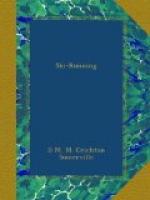(2) Solid bindings. The commonest forms of these are the Ellesen, Lilienfeld and Bilgeri, but as I have never tried any of them, I can say nothing about them.
(3) Heel bindings. There are two main forms of these—the Lap thong and the Huitfeldt. The Lap thong is merely a long strap of raw hide or leather. A loop is drawn through the hole under the toe iron, the long end is taken round the heel and through the loop, then back round the heel and through a slit in the other or short end. The long end is then carried under the foot and round the instep and finally tied off with a knot. This has been improved upon by a ring and buckle being added to save slitting the leather or knotting the ends.
The Huitfeldt binding is a thick double-leather strap, which buckles round the whole foot and has a strong spring to pull it taut when the binding has been slipped on to the heel. This is the usual binding on hired Skis.
I have tried both these bindings, and now wear a Scheer binding, which is a combination of the two—the long Lap thong with buckles and also a spring similar to the one tightening a Huitfeldt binding. The chief drawback to a Lap binding was that it took time to put on so that fingers got very cold and clumsy when fitting it before a run down from a height. The trouble about a Huitfeldt binding is that it is thick and clumsy and the buckles stick out so that they catch in the snow when running.
The Scheer binding avoids these drawbacks. It is put on just as easily as a Huitfeldt and the thin thong lies so closely along the boot that there is nothing to catch in the snow. It is very easily lengthened or shortened when the leather contracts or stretches and this is also a great comfort. This binding being new, may not yet be obtainable everywhere, but it is well worth trying to get. The Huitfeldt and Scheer bindings both tend to give a little in a strained fall, so that the foot slips round and the leg is usually saved.
Toe irons pass through the Ski under the toes and come up either side to hold the foot in place. They should be carefully fitted and, with a view to this, the boots should be left overnight with the sports shop and the Skis fetched next day. The boot should lie quite straight along the Ski. If the toe irons do not fit properly, the boot will be cock-eye on the Ski, and too much free play may take place. I have often seen beginners take advantage of this to stick their heels out and off the Ski into the snow to help them uphill, or to act as a brake downhill. They will rue it downhill, however, as the foot should be firmly held on the Ski or control will be impossible.
Toe irons are sometimes made of very soft metal. These are usually attached to Skis hired out by the sports shops in order that they may be easily fitted to the many different shaped feet of the hirers. When getting toe irons fitted to one’s own Skis, it is wise to ask for strong ones, as the soft irons give too freely to the pivotal action of the feet in turns and tend to be constantly opening and becoming loose.




